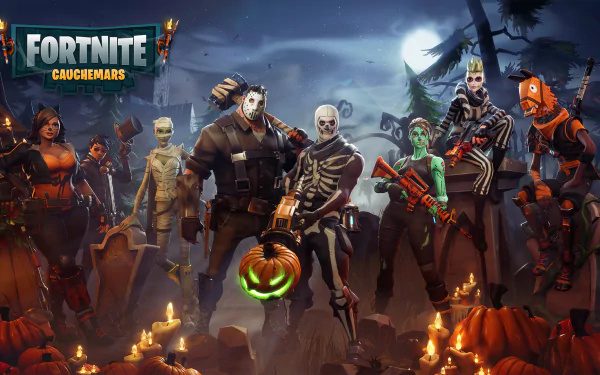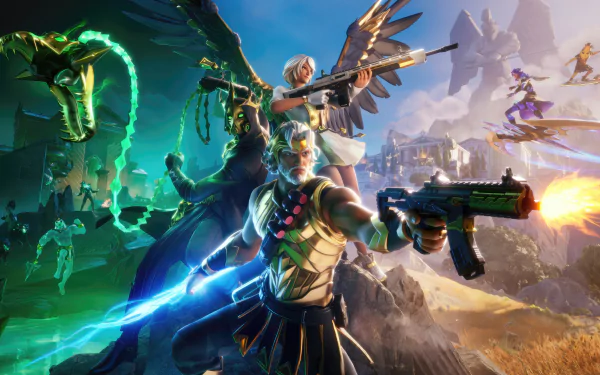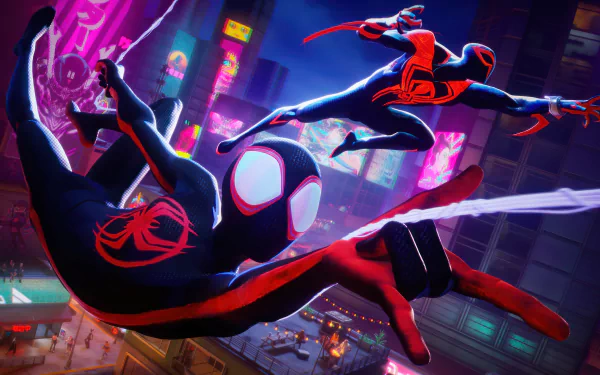Since its release in 2017, Fortnite has taken the gaming world by storm. Developed by Epic Games, this battle royale sensation quickly became a cultural phenomenon, attracting millions of players worldwide. The game blends fast-paced action with creative building mechanics, offering a unique experience that keeps players coming back for more.
Gameplay
At its core, Fortnite is a battle royale game where 100 players drop onto an island and fight to be the last person or team standing. What sets Fortnite apart from other games in the genre is its building mechanic. Players can harvest resources like wood, brick, and metal to construct structures such as walls, ramps, and floors. This adds a strategic layer to the combat, allowing players to build cover, gain high ground, and outmaneuver opponents in creative ways.
The gameplay is fast-paced and often chaotic, with firefights quickly turning into intense building battles. The map constantly changes due to the “storm” shrinking the playable area, forcing players into close encounters. This keeps matches engaging and ensures that no two games are the same.
Graphics and Visuals
Fortnite’s art style is one of its most recognizable features. Unlike other battle royale games that opt for a realistic and gritty look, Fortnite takes a more colorful and cartoonish approach. The vibrant graphics make the game visually appealing and accessible to players of all ages. Epic Games frequently updates the map and introduces new in-game events, providing a fresh visual experience with each season.
Game Modes and Content
Fortnite offers several game modes beyond the standard battle royale. Creative Mode allows players to design and build their own custom maps, mini-games, and experiences. This has led to an explosion of user-generated content, with some maps becoming popular in their own right. There’s also Save the World, a cooperative PvE mode where players fight off waves of enemies while building and defending structures.
Epic Games consistently releases new content, including skins, emotes, weapons, and limited-time events. Crossovers with popular franchises like Marvel, Star Wars, and Naruto have brought iconic characters and unique gameplay elements into the Fortnite universe. These regular updates and collaborations keep the game fresh and exciting, giving players new reasons to log in and explore.
Monetization and Battle Pass
Fortnite is free to play, but it employs a microtransaction model for revenue. The game offers a Battle Pass, a tiered system where players can unlock rewards like skins, emotes, and other cosmetic items by completing in-game challenges. While the Battle Pass costs V-Bucks (the in-game currency, which can be purchased with real money), it offers a generous amount of content and gives players a sense of progression.
The item shop also features daily and weekly rotations of cosmetic items that players can purchase directly. Notably, these purchases do not affect gameplay, ensuring that Fortnite remains a fair and competitive experience for all players.
Community and Cultural Impact
Fortnite’s impact on gaming culture cannot be overstated. It has become a social platform where players gather not just to play but to watch live events, concerts, and movie screenings. Epic Games has hosted virtual concerts featuring artists like Travis Scott and Ariana Grande, drawing millions of viewers worldwide. The game’s influence extends beyond the screen, with Fortnite dances and emotes becoming viral trends on social media.
The game also has a strong esports scene, with tournaments offering millions in prize money. The 2019 Fortnite World Cup was a landmark event, attracting competitors of all ages and proving that Fortnite could hold its own in the competitive gaming world.

Criticisms
While Fortnite is praised for its innovation and constant updates, it has not been without criticism. Some players feel that the game can be overly complicated, especially for newcomers, due to the high skill ceiling associated with building and editing. Additionally, the game’s monetization strategies, particularly the frequent release of new cosmetics, have raised concerns about encouraging excessive spending among younger players.
Is Fortnite the Best Game? A Comprehensive Look
Fortnite has been a gaming sensation since its release in 2017. Developed by Epic Games, this free-to-play battle royale game has attracted millions of players globally, from casual gamers to dedicated esports professionals. But with the gaming world constantly evolving and new titles emerging, the question arises: Is Fortnite really the best game out there?
What Makes Fortnite Stand Out?
- Unique Gameplay Mechanics
One of Fortnite’s defining features is its unique blend of shooting and building mechanics. Unlike traditional battle royale games, Fortnite allows players to gather resources and construct structures on the fly. This building element adds a layer of strategy and creativity to the game, allowing players to create cover, gain high ground, and outmaneuver opponents in innovative ways. - Constant Updates and Fresh Content
Fortnite is known for its frequent updates and new content. Every few months, Epic Games releases a new season, often introducing major changes to the game map, new weapons, and gameplay mechanics. Additionally, Fortnite hosts limited-time events and crossovers with popular franchises like Marvel, Star Wars, and DC Comics. These constant updates keep the game feeling fresh and exciting, giving players new reasons to return. - Free-to-Play Model with Fair Monetization
Fortnite is free to download and play, making it accessible to a wide audience. The game’s primary monetization comes from its Battle Pass and in-game store, where players can purchase skins, emotes, and other cosmetic items. Importantly, these purchases do not affect gameplay, ensuring a fair playing field for everyone. Players are not required to spend money to compete or enjoy the game fully. - Community and Cultural Impact
Fortnite has transcended the gaming world to become a cultural phenomenon. It has hosted virtual concerts featuring artists like Travis Scott and Ariana Grande, and its in-game events often draw millions of viewers. The game has also made a significant impact on social media, with its dances and emotes becoming viral trends. This cultural relevance has made Fortnite more than just a game; it’s a social platform and entertainment hub.
The Case Against Fortnite Being the “Best” Game
- Steep Learning Curve
While Fortnite’s building mechanic is a unique feature, it also contributes to a steep learning curve. New players often find it challenging to compete against seasoned players who can build complex structures in seconds. This skill gap can be discouraging for newcomers, making it less accessible compared to other games that rely solely on shooting mechanics. - Frequent Changes and Complexity
Fortnite’s constant updates can be a double-edged sword. While they keep the game fresh, they can also make it overwhelming for casual players to keep up. New weapons, mechanics, and map changes are introduced regularly, and what works one season may be obsolete the next. Some players prefer games with a more stable and predictable meta, where they can master the gameplay without needing to adapt constantly. - Monetization Concerns
Although Fortnite’s microtransactions are cosmetic-only, the game frequently releases new skins, emotes, and other items, often playing into the fear of missing out (FOMO). This can lead to players, particularly younger ones, feeling pressured to spend money to keep up with trends or show off rare items. While this model is common in free-to-play games, it has raised concerns about encouraging excessive spending. - Competition in the Gaming Market
The gaming market is incredibly diverse, with games catering to various tastes and preferences. Titles like “Call of Duty: Warzone,” “Apex Legends,” and “Minecraft” offer different experiences that appeal to different player bases. Some gamers may prefer the realistic combat of Warzone or the hero-based gameplay of Apex Legends over Fortnite’s building and cartoonish art style. Additionally, single-player games like “The Legend of Zelda: Breath of the Wild” or “Red Dead Redemption 2” offer narrative-driven experiences that Fortnite does not provide.

So, Is Fortnite the Best Game?
The answer largely depends on personal preference. For those who enjoy fast-paced action, strategic building, and a constantly evolving game world, Fortnite may indeed be one of the best games available. Its blend of accessibility, competitive depth, and cultural impact make it a standout title in the battle royale genre. However, it’s not without its flaws. The steep learning curve, constant changes, and monetization strategies may not appeal to everyone.
Moreover, the gaming landscape is vast, and what is “best” can vary greatly depending on what a player values in a game. Some players might prefer the realistic and tactical gameplay of other shooters, the storytelling of narrative-driven games, or the sandbox creativity of games like Minecraft.
Fortnite is undeniably one of the most influential and popular games of recent years. Its innovative gameplay mechanics, regular updates, and cultural relevance have made it a powerhouse in the gaming world. While it may not be the “best” game for everyone, it has certainly earned its place as a landmark title that continues to shape the gaming industry. Whether Fortnite is the best game depends on what you seek in a gaming experience, but it’s hard to deny its impact and appeal to millions of players worldwide.
Fortnite Gameplay: A Deep Dive into Battle Royale and Beyond
Fortnite, developed by Epic Games and released in 2017, quickly became a global sensation, primarily due to its innovative gameplay mechanics and unique blend of elements. From intense battle royale matches to creative building mechanics, Fortnite offers a dynamic gaming experience that sets it apart from other titles in the genre. Let’s break down the core gameplay aspects that make Fortnite a standout title.
The Battle Royale Experience
At its core, Fortnite is a battle royale game where up to 100 players drop onto an island and fight to be the last person, duo, or squad standing. Players start the match on a flying bus (“Battle Bus”) and can choose where to drop on the map. The decision of when and where to land is crucial, as it affects the initial phase of the game, including the availability of weapons, shields, and other resources.
- Looting and Resources
Once on the ground, players must scavenge for weapons, ammunition, and shields to prepare for combat. Fortnite offers a variety of weapons ranging from common to legendary, each with its own strengths and weaknesses. Players can also find healing items, traps, and throwables like grenades, adding depth to combat strategies.Besides looting weapons, players gather materials like wood, brick, and metal by destroying objects in the environment. These resources are essential for building structures, a mechanic that adds a unique strategic layer to the game. - Building Mechanics
One of Fortnite’s most defining features is its building system. Players can use harvested materials to construct walls, ramps, floors, and roofs. This mechanic allows players to create cover, build fortifications, and gain high ground quickly. Mastering building is key to success in Fortnite, as it can drastically change the outcome of firefights.Advanced players can build complex structures in the heat of battle, using them to defend against attacks or launch counter-offensives. This dynamic aspect of gameplay sets Fortnite apart from other shooters and creates a high skill ceiling, rewarding players who can build efficiently under pressure. - Combat and Weapons
Fortnite’s combat is fast-paced and requires a combination of aiming skills, quick reflexes, and strategic thinking. The game offers a diverse arsenal, including assault rifles, shotguns, sniper rifles, explosives, and more. Each weapon has different damage rates, fire rates, and optimal ranges, encouraging players to adapt their playstyle based on the weapons they find.The interplay between shooting and building makes Fortnite’s combat unique. Skilled players often build defensive structures while firing at enemies, leading to dynamic and unpredictable encounters. The ability to out-build an opponent is just as important as outshooting them. - The Storm and Circle Management
As the match progresses, a storm closes in on the island, shrinking the playable area and forcing players into closer proximity. Managing your position relative to the storm is crucial, as being caught outside the safe zone results in damage over time. This shrinking circle ensures that matches remain intense and fast-paced, pushing players toward confrontation and preventing prolonged camping.
Game Modes Beyond Battle Royale
- Creative Mode
Creative Mode is Fortnite’s sandbox mode, where players have the freedom to build their own maps, mini-games, and experiences. Whether it’s creating a parkour course, a custom deathmatch arena, or an intricate puzzle, Creative Mode empowers players to let their imaginations run wild. This mode has given rise to a thriving community of creators who design unique experiences that other players can explore. - Save the World
Save the World is Fortnite’s original cooperative mode, where players work together to fight off waves of zombie-like creatures called Husks. In this PvE mode, players collect resources, build defensive structures, and complete missions. While it has taken a backseat to the battle royale mode in terms of popularity, Save the World still offers a fun, cooperative experience that focuses more on building and defending than direct player-vs-player combat. - Limited-Time Modes (LTMs)
Epic Games frequently introduces Limited-Time Modes (LTMs) to keep gameplay fresh and exciting. These modes often introduce unique rules, objectives, or mechanics that deviate from the standard battle royale format. Examples include “50v50,” where two large teams battle it out, or “Sniper Shootout,” where only sniper rifles are available. LTMs offer players a chance to experience Fortnite in new ways and often tie into special events or holidays.

Map Evolution and In-Game Events
One of the key elements that keep Fortnite’s gameplay engaging is the evolving game map. With each new season, Epic Games introduces changes to the island, such as new locations, altered landscapes, and environmental hazards. These updates not only provide a fresh experience each season but also add to the game’s lore and narrative.
In addition, Fortnite is known for its live in-game events, which have become major spectacles within the gaming community. Events like the rocket launch, the black hole event, and live concerts with artists like Travis Scott and Ariana Grande have captivated millions of players and added a sense of unpredictability and excitement to the game.
Strategy and Skill Development
Success in Fortnite requires a blend of strategic thinking, mechanical skill, and adaptability. Players must decide when to engage or avoid combat, manage resources, and use building mechanics to their advantage. The game’s high skill ceiling ensures that there is always room for improvement, whether it’s honing your building speed, mastering new weapons, or learning advanced movement techniques.
Fortnite’s gameplay offers a unique and dynamic experience that sets it apart from other games in the battle royale genre. Its blend of fast-paced combat, strategic building mechanics, and ever-changing map ensures that no two matches are the same. Whether you’re drawn to the competitive aspect of battle royale, the creative freedom of building, or the cooperative gameplay in Save the World, Fortnite provides a multifaceted experience that appeals to a wide range of players.
Its evolving nature, combined with Epic Games’ commitment to regular updates and in-game events, ensures that Fortnite remains fresh and engaging. For those who embrace its fast pace and depth, Fortnite delivers an action-packed and strategic gameplay experience that is both challenging and rewarding
Conclusion
Fortnite continues to be one of the most influential games of the modern era. Its blend of fast-paced combat, creative building mechanics, and ever-evolving content has carved out a unique niche in the gaming landscape. While it may not appeal to everyone, its impact on the industry and popular culture is undeniable. Whether you’re a casual player looking for a fun, social experience or a competitive gamer seeking the thrill of a battle royale victory, Fortnite offers something for everyone.
Rating: 9/10
Fortnite excels in delivering a dynamic and entertaining experience. Its constant updates and evolving gameplay keep players engaged, while its accessible yet challenging mechanics make it a standout title in the crowded battle royale genre
